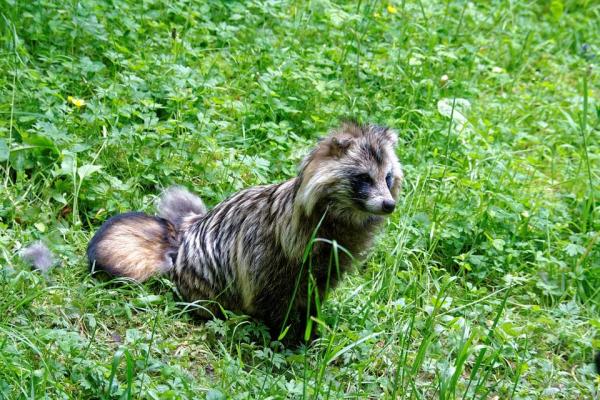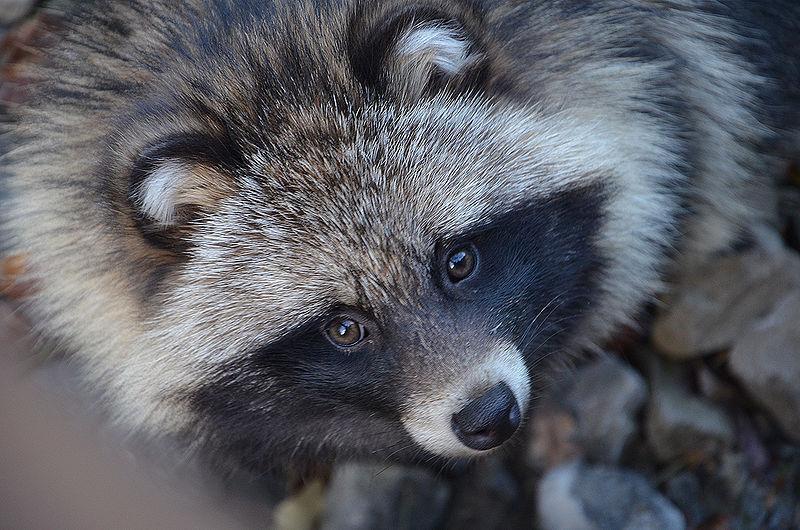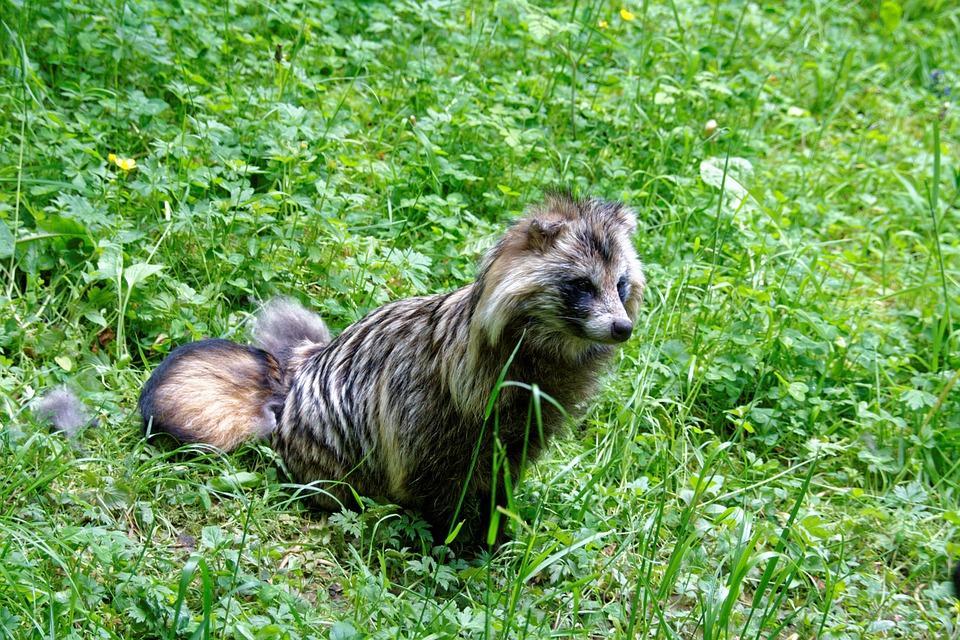What Is a Raccoon Dog? - Types and Facts


Are they dogs? Are they raccoons? Are they a hybrid of the two species? As the name suggests, raccoon dogs appear to be a combination of the two, but this is not the case. Only under very specific circumstances can two animal from different species mate. Raccoon dogs are members of the genus Nyctereutes, of which there are only two extant species. Native to Asia, they are taxonomically closer to dogs since they are a type of ancient canid. Despite this, their markings and skull shape mean they bear a very close resemblance to raccoons.
At AnimalWised, we learn more by asking what is a raccoon dog? We look at the different types of raccoon dogs with facts about each such as their diet, habitat and behavior. We also provide photos of raccoon dogs so you can compare these species for yourselves.
What is a raccoon dog?
The raccoon dog is an animal belonging to the genus Nyctereutes. Within this genus are two separate extant species. Both share similar characteristics in terms of physical appearance and behavior. Despite their outward resemblance to raccoons, these animals are genetically related to domestic dogs, foxes and wolves. For this reason they are considered a species of wild dog. It is why they are called raccoon dogs and not dog raccoons.
The raccoon dog is a basal or an ancestral species, meaning they have remained relatively unchanged since they first diverged form other canid species. While there are two extant species of the Nyctereutes genus, there are various extinct species. Raccoon dogs have their origins in Asia and were one of the first canids known to have traveled to the Old World.
Types of raccoon dogs
As we have stated, all raccoon dogs are from the genus Nyctereutes. Of the seven known species, only two are extant. These are the following:
- Common raccoon dog (Nyctereutes procyonoides): also known as the Asian or Chinese raccoon dog in English, as well as the mangut and neoguri in Evenki and Korean, respectively.
- Japanese raccoon dog (Nyctereutes viverrinus): also known as the tanuki in Japanese. This is the type of raccoon dog shown in the photo below.
While we now consider them two separate species, it was once believed that the Japanese raccoon dog was actually a subspecies of the common raccoon dog, specifically Nyctereutes procyonoides viverrinus. However, genetic testing has shown that significant genetic differences exist in these species, enough to make them separate[1]. The two species are likely to have developed and evolved in two separate locations isolated from each other to result in these species differences.

Origin of the raccoon dog
Raccoon dogs are native to East Asia, which is why they are often called Chinese and Japanese raccoon dogs. It is also why their common names of tanuki, mangut and neoguri are from Asian languages. The exact time the species emerged in Asia is debated, but the direct ancestors of present day Japanese raccoon dogs are believed to have been isolated on the islands about 12,000 years ago[2].
Japanese raccoon dogs became popular animals in Japan around the 18th century. This was when the tanuki became an icon of the country. It soon began to be considered a symbol of good fortune. Tanuki are an important part of Japanese folklore, with several legends and stories centered around the Japanese raccoon dog.
The common raccoon dog is native to mainland southeast Asia, where it is found in parts of China, Korea and Vietnam. It is also seen in southeast Russia, eastern Siberia and Mongolia where the raccoon dog is called mangut.
During the early to mid 20th century, raccoon dogs were introduced, through the Soviet Union, into Eastern and Northern Europe. This was due to the popularity of their fur, which was highly appreciated. While they are still hunted for their fur, this practice has declined in recent decades. Raccoon dog farms were created in former Soviet Union territories in Asia and Europe, from where some raccoon dogs were deliberately released into the wild while others escaped captivity on their own.
These animals spread fast from the places where they were introduced, thanks to their resistance, adaptability and ability to withstand extreme low temperatures. Raccoon dogs can currently be found in many parts of Europe, including countries such as France, Denmark or Germany, where they are often considered an invasive species. we will look further into this below. Today, Finland has the highest population of raccoon dogs outside their native territory.
If you are interested domestic dog breeds from Asia, here is a list of native Asian dog breeds.
Raccoon dog facts
The raccoon dog is a very peculiar animal, not only because of its deceptive looks, but also because of its unique habits and behavior. Here are some facts about the raccoon dog which should answer many questions you may have about this unusual canid species:
Where do raccoon dogs live?
The Japanese raccoon dog is most commonly found in Japan where it inhabits forests, mountains and rural areas of the islands. They can sometimes be found in the outskirts of cities or in urban habitats with little forest cover, much like the unrelated raccoon. In the places where they have been introduced, raccoon dogs inhabit moist forests and meadows, staying close to bodies of water. They have been seen to escape into water when being chased.
Common raccoon dogs have a much wider distribution in Asia, inhabiting parts of China, Korea, Mongolia and Siberia. They have been introduced to other areas including European countries such as Denmark, Estonia and Finland. Japanese raccoon dogs are not naturally found outside Japan and common raccoon dogs are not found inside Japan.
Raccoon dogs are known for their ability to withstand very low temperatures and high snowfall. At the northern end of their range, in Finland for example, they can be found in places where the annual average temperature is just above 0ºC (32ºF).
What do raccoon dogs eat?
Raccoon dogs are omnivorous animals and vary their diet according to season. In addition, they are opportunistic generalists, so they usually get their food from almost any source that is available to them. They often eat small rodents, insects and reptiles such as toads and occasionally prey on waterfowl and freshwater fish. As types of scavenger animals they are also known to feed on carrion and garbage. In summer and autumn they eat more berries, fruit and sometimes cereals or other agricultural produce.
What do raccoon dogs look like?
As we have explained, raccoon dogs are not genetically related to the raccoon family, although they share an uncanny resemblance. Both have a black facial mask and pointed muzzle, as well as yellowish-brown to gray fur. Albino tanuki have been recorded[3], although animal albinism is rare among raccoon dogs.
The similarities between raccoon dogs and raccoons can be explained by the convergent evolution, which is when two unrelated species evolve similar traits by adapting to the demands of similar niche habitats. One feature that distinguishes them are their canid-like paws, which look nothing like the raccoon's five toes.
Raccoon dogs are medium sized, weighing between 8.8-20 lb (4-9 kg). They have two two layers of fur, with a short and bushy undercoat, and a long, dense outer coat. Raccoon dogs change in appearance between summer and winter. Before winter sets in, they double their weight and grow thick fur, which protects them from the cold and gives them a very round appearance. By summer, their coat thins and they go back to their previous weight.
Although they look similar, common raccoon dogs tend to be slightly bulkier in build than their Japanese counterparts. The Japanese raccoon dog has a slightly more reddish coat color and less pronounced facial markings the common raccoon dog has very distinct eye markings and a darker coat.
Hibernation and monogamy in raccoon dogs
An interesting fact about the raccoon dog is that it is the only canid species that hibernates. Unusually for a hibernating species, however, its body temperature does not drop. The accumulation of fat reserves during summer and autumn helps them keep their temperature constant and withstand even the coldest winters.
Another unique feature of the raccoon dog is that it is monogamous. This means that males and females form pairs for life. They share a range, and move together throughout the year, as well as feeding and foraging together. In addition, male and female raccoon dogs raise their young together, taking turns foraging and ‘babysitting’[1].

Are raccoon dogs dangerous?
Raccoon dogs are usually harmless and are not known to attack humans. However, being wild animals they tend to be cautious and fearful, running away or hiding from humans and other possible predators. If they feel threatened, it may be possible for raccoon dogs to snarl or exhibit what appears to be aggressive behavior[4]. It is in fact dangerous for them to travel through urban areas, since in the face of possible dangers, such as cars, they remain petrified, often succumbing to traffic accidents.
The raccoon dog as an invasive species
Due to their adaptability and opportunistic feeding habits, raccoon dogs can often become invasive species. They have recently been classified as such by the European Union[5], and are listed as ‘injurious wildlife’ according to the US Fish and Wildlife Service[6]. The biological characteristics of the raccoon dog also make it an ideal host for several types of parasites and viruses, which is why it can be considered dangerous to human health in regions where it thrives in high numbers.
Raccoon dogs can potentially transmit a number of deadly zoonotic diseases to domestic animals or to humans. They are known to carry 35 endoparasites, plus ectoparasites, bacteria and viruses. Raccoon dogs are a key carrier of rabies and scabies (mange) in Europe, both of which can easily infect domesticated animals. They also act as vectors for parasites such as Trichinella spp or Echinococcus multilocularis, a dangerous tapeworm which can infect humans as well[7]. This does not mean that raccoon dogs have to be eliminated wherever they are found, but that their populations need to be kept in check in countries where they are not a native species.

Can you keep a raccoon dog as a pet?
While raccoon dogs can be adorable-looking, they are not meant to be domesticated or made to live in our homes. As we have explained, raccoon dogs are a wild species, and have several problems associated with them. As a potential invasive species, raccoon dogs that escape captivity or are deliberately released into the wild can wreck havoc on native species. As in the photo above, raccoon dogs should be free to roam in the wild.
In addition, although some raccoon dogs are kept in captivity - in zoos for example - they are not well adapted to life in within four walls. Raccoon dogs have lived close to humans for centuries, and have never been successfully domesticated. Furthermore, they have proved wily escape artists, and it is best for them to live out their lives in in the wild rather than in forced captivity.
Furthermore, it is illegal to breed, keep or bring in raccoon dogs in many countries, as they are often listed as an invasive species. Even where it may be legal we recommend that do not keep a raccoon dog as a pet. Organizations such as the RSPCA also strong recommend against keeping raccoon dogs as pets[8].
If you want to read similar articles to What Is a Raccoon Dog? - Types and Facts, we recommend you visit our Facts about the animal kingdom category.
1. Nie, W., et al. (2003). Comparative chromosome painting defines the karyotypic relationships among the domestic dog, Chinese raccoon dog, and Japanese raccoon dog. Chromosome Research, 11(8). https://link.springer.com/article/10.1023%2FB%3ACHRO.0000005760.03266.29
2. Kauhala, K., & Saeki, M. (2004). Raccoon dogs: Fennish and Japanese raccoon dogs - On the road to speciation? In D. W. MacDowell & C. Sillero-Zubiri (Eds.), The biology and conservation of wild canids (pp. 217-226). Oxford University Press.
3. Japan Times. (2013, October 18). Rare white raccoon dog caught. https://www.japantimes.co.jp/news/2013/10/18/national/rare-white-raccoon-dog-caught/#.XeUo15NKjIV
4. Gutman, R. (2019, June 21). The care and keeping of raccoon dogs. The Atlantic. https://www.theatlantic.com/science/archive/2019/06/the-care-and-keeping-of-raccoon-dogs/590800/
5. International Union for Conservation of Nature (IUCN). (n.d.). EU regulation on invasive alien species. https://www.iucn.org/theme/species/our-work/invasive-species/eu-regulation-invasive-alien-species
6. U.S. Fish and Wildlife Service (FWS). (2019). Summary of species currently listed as injurious wildlife under the Lacey Act (18 U.S.C. 42). https://www.fws.gov/
- Invasive Species Compendium. (2019). Nyctereutes procyonoides (raccoon dog). Retrieved October 11, 2024, from https://www.cabi.org/isc/datasheet/72656#toidentity
- Kauhala, K., & Saeki, M. (2004). Raccoon dog Nyctereutes procyonoides. IUCN. Retrieved October 11 2024, from https://web.archive.org/web/20090219205621/http://canids.org/species/Raccoon_dog.pdf
- Kauhala, K., & Saeki, M. (2016). Raccoon dog. The IUCN Red List of Threatened Species 2016: e.T14925A85658776. Retrieved October 11, from https://www.iucnredlist.org/species/14925/85658776
- Wilson, D., & Reeder, D. (Eds.). (2005). Nyctereutes procyonoides. In Mammal species of the world (pp. 2142). Johns Hopkins University Press.






 White are rare ??? Where are your sources of info from? And any exotic animal has it it bad points it’s people thinking they similar to a domestic species then it don’t behave like that is when it becomes a issue my white one sleeps in bed with me and also they can pair with males as I have two bonded male brothers
White are rare ??? Where are your sources of info from? And any exotic animal has it it bad points it’s people thinking they similar to a domestic species then it don’t behave like that is when it becomes a issue my white one sleeps in bed with me and also they can pair with males as I have two bonded male brothers



